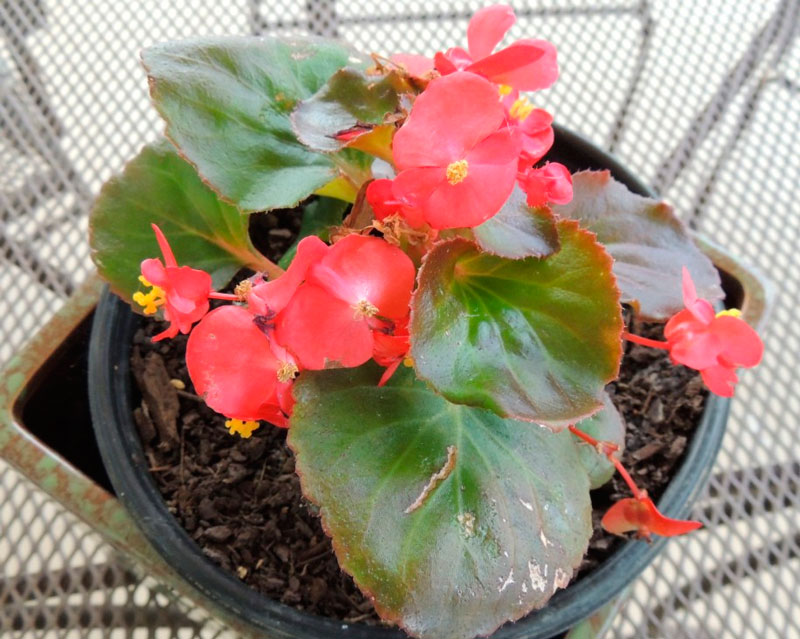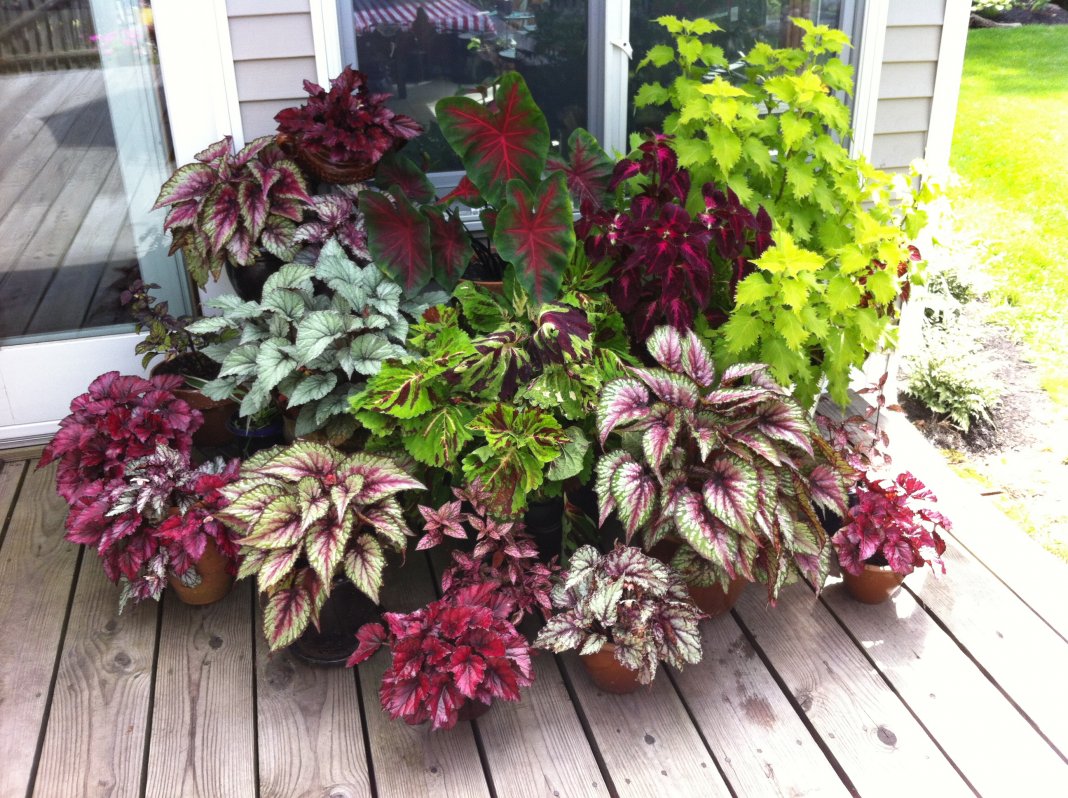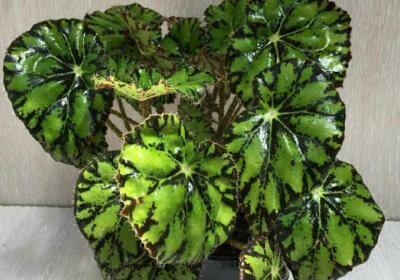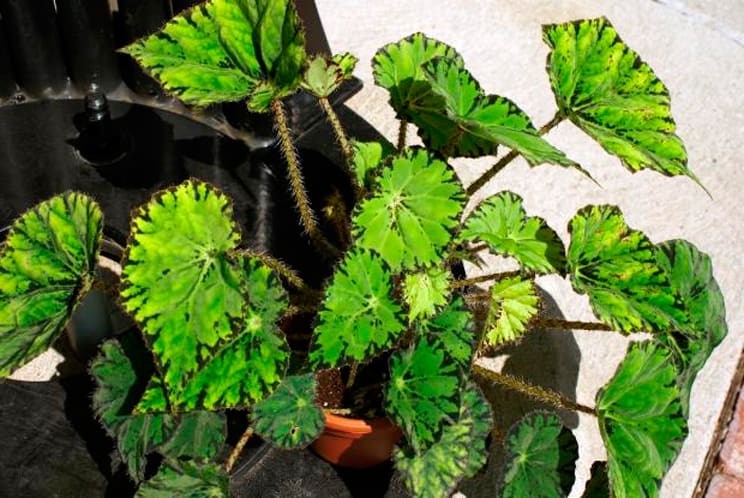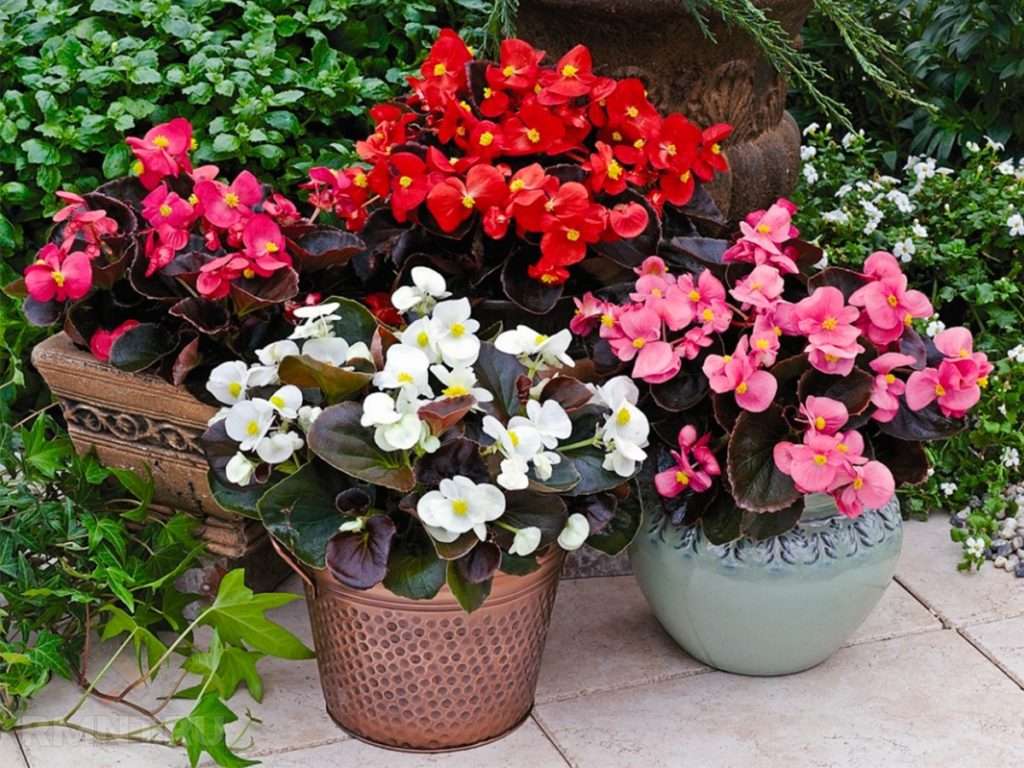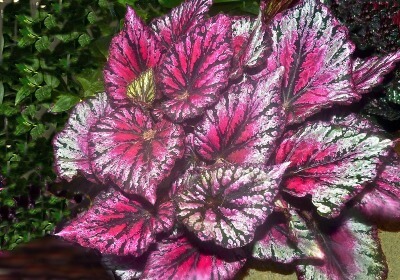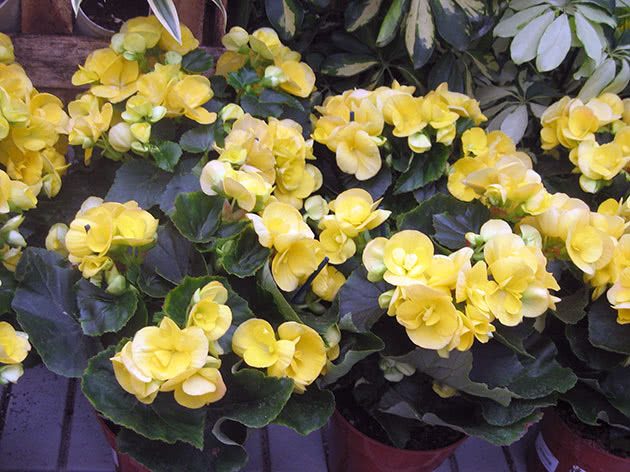Breeding methods for indoor begonia
How to propagate begonia
Such a plant can be propagated by seed or vegetative (stems, leafy cuttings, dividing a bush or a tuber or rhizome) in a way. The easiest and fastest way is vegetative.
Growing begonias from seeds
Growing begonia from seeds can be quite easy and fast. Sowing is carried out in the last days of February or the first of March. To do this, small seeds must be spread over the surface of the substrate (do not cover). Then the container must be moved to a well-lit, warm place, covering it in advance with plastic wrap or glass. You need to water the crops through a pallet or using a sprayer. After the first seedlings appear, it is necessary to remove the shelter for good. The pick is made after the plants have 3 or 4 true leaf plates. After 8 weeks, young plants can be transplanted into individual pots. Such begonias can begin to bloom in the first year of growth, however, in order for this to happen, they often need additional lighting.
Dividing the tuber (rhizome) of begonia
For the propagation of deciduous species, the division of the rhizome is used. This procedure is carried out in the spring. To do this, you need to pull the flower out of the soil and divide the rhizome into several parts with a very sharp knife, and each division must have roots and at least 1 shoot or bud. Places of cuts must be sprinkled with crushed charcoal. After that, the delenki are planted in individual containers.
The tuber of an adult plant can also be divided into several parts. After that, you need to wait until the places of the cuts dry a little and sprinkle them with chopped charcoal. Then the delenki are planted in individual containers.
Propagation of begonias by cuttings
The simplest of all vegetative breeding methods for begonias is cuttings. It is necessary to cut off cuttings from a bush that have 3 or 4 leaf plates. In order to prevent rot on the cuts, they must be treated with charcoal. Then the cutting must be planted in a mixture of leaf and peat soil and sand in a ratio (1: 1: 1). The container is placed in a well-lit and warm place, in which there is no access to the direct rays of the sun. The cuttings need moderate watering, so it is necessary to moisten the soil only after the soil dries out to a depth of 1 to 2 centimeters. You can root the cuttings by immersing them in a glass of water. The roots will grow back in about 4 weeks.
Begonia leaf propagation
Since most species have rather large and dense leaf plates, they can be propagated by leaf cuttings. In this case, both the whole leaf plate and part of it are suitable for reproduction. If begonias are propagated with a whole leaf, then the main veins must be cut on its seamy side. Then the sheet plate is laid with the cut side on the surface of the moistened sand, which must be calcined in advance. After that, it is fixed in this position. Watering is carried out through the pallet. After about 8 weeks, roots will appear from those places that are incised, and after a while young plants will begin to grow. The grown grown young begonias must be separated and planted in an earthen mixture consisting of deciduous soil, peat and sand in a ratio (1: 1: 1).
Basic principles of flower care
Light. Diffused light is the main condition for the formation of the correct pattern on the leaf plates of begonias.If possible, keep the pot on a southeast or southwest windowsill.
Temperature. The lowest temperature bar for a heat-loving plant is +18 degrees. The warmer it is in the room, the more flowers the flowerpot can grow.
Watering. In summer, the flowerpot is watered when the soil in the pot dries up. In winter, watering is done even less often. Tap water, if you do not have high-quality filters, use only settled water (for at least a day, and in an open cup or jar). For watering, it must be warm, so if you stand on a cold balcony, warm it up
It is important to pour moisture exclusively onto the ground - the leaves and stem are afraid of water, so begonia is not sprayed.
Humidity. Both in summer heat and in winter (with dry air due to batteries), it is better to keep the plant on a tray with wet moss or expanded clay.
Nutrition
From mid-spring to mid-autumn, the bush is pampered with a complex mineral fertilizer. It is diluted with water and poured into the soil after watering. Make sure that the food does not turn out to be too concentrated - when diluting, it is better to pour more water than less. The frequency of feeding is 1 time per 4 weeks.

Transfer
Frequency of transplants: maximum once every 2 years, since this decorative culture is delicate and does not tolerate such a procedure very well. However, if the flowerpot is young, it is better to transplant it annually, otherwise the rapidly growing roots will become cramped in the pot. A transplant is carried out in the spring.
The best soil recipe: leafy, coniferous, sod land, humus and sand (in equal proportions).
Also, do not forget two points: first, put expanded clay on the bottom of the pot for drainage; secondly, do not fill the pot with soil to the very top - the roots will begin to grow, pushing out part of the earth, and your entire windowsill will be constantly dirty.
And so that the pot does not seem empty, lay sphagnum on top of the soil - you will get both a beautiful picture and additional safety (moss is a good antiseptic that protects the roots from rotting).
- Pot: wide but not deep. The roots of the flower do not grow in depth, but in breadth. It is good if it is made of clay.
- Transfer method: gentle handling.
When transplanting, it is recommended to cut off all the leaves (but I don’t do that) and put the flowerpot in the shade for a while to get rid of stress faster.
You will see the flower transshipment step by step here:
Treatment and prevention
Diseases. The main "ailments" of Bauer's begonias are associated with stagnation of liquid near the roots or the ingress of water on the leaves.
- Powdery mildew. In a liter of water, dilute 20 g of special green (but you can take pharmacy tar soap) and 2 g of copper sulfate. Spray the bush.
- Gray rot. If with powdery mildew the bush is covered with whitish spots, then with gray rot - grayish. A solution of Bordeaux liquid can save your pet. The previous recipe (green soap, copper sulfate, water) is also suitable.
- Root rot. If you dug a bush and saw that the roots are wet, covered with something grayish, the begonia can still be saved. Change the soil, put the pot in a warm place, and water it much less often than before.
Pests. Begonia is afraid of felts and aphids. A sick flowerpot needs to be oiled with an insecticide without delay. It is better to do this in the summer and on an open balcony (your family should not breathe such poison).
If it is winter outside and there are still few aphids, you can try to remove them manually (by dropping them with a cotton swab into the sink), and then treat the flowerpot with soapy water.

What other problems can you face?
- The leaves turn yellow. Either the bush has little light, or you are watering it incorrectly.
- The leaves first curl up, then fall off. Most likely, the flower is hot. Is he standing over a "breathing fire" radiator? Leaves may fall in a too dark room. And if they are rotten at the same time, you fill the flower.
- The tips of the leaves dry up and turn brown. The air is very dry.Since the begonia must not be sprayed, keep it on a tray / sump with poured clay or moss, and away from the aforementioned radiator and other heaters that are on.
- The leaves are pale and begin to rot. Overflow is taking place.
And if the bush is old and loses its decorative effect, it can be rejuvenated by removing part of the old trunk, as well as the root system. Here's how an experienced florist does it:
Varieties and photos
Below are photos, names and descriptions of ampelous begonia varieties suitable for planting and care at home.
Chanson
An ornamental plant, distinguished by double, semi-double inflorescences. Consists of 5-7 large processes 30 to 45 centimeters long. It blooms profusely, for a long time, the leaves of the flowers are wide, bright in color. There are extraordinary double colors. Graceful hanging shoots look elegant in hanging baskets, flowerpots, high flowerpots, where the plant can show its ampelous shape.
The flower gradually grows tubers, which are well preserved for the next season. The plant loves lighted areas, but is tolerant of partial shade. Prefers soil rich in organic matter, responds well to frequent moisture. The photo below shows Begonia Ampelnaya Chanson:
Golden Balconi
Suitable for decorating recreation areas - a garden plot, a loggia, a room. It picks up many buds at once, blooms profusely, for a long time, for several months. Does not lose the brightness of flowers for a long time. When placing the plant outdoors, you need to protect it from drafts. If the culture is always indoors, it is necessary to provide an influx of fresh air.
The variety prefers shady places or diffused sunlight. Water should be abundant, but not overdone. When it has bloomed, you need to smoothly stop watering. Then cut off the aerial part, and leave the nodules for storage, moistening the soil from time to time. In the spring they are planted in a new substrate, fertilized and watering resumed. What the Begonia Ampelnaya Golden Balconi variety looks like can be seen in the photo below:
Scarlett
Spectacular, beautiful variety, 25 cm high with double flowers. Their petals have a diameter of 18-20 centimeters. Flowers are peony, pink, camellia, daffodil and fringed. In good light, the entire bush is covered with flowers. Needs additional fertilizing for good vegetation and full flowering. In March, the flower is fed twice with nitrogen fertilizers.
When the plant begins to bloom, it is advisable to add minerals without exceeding the dosage. You can feed the culture with organic matter in the summer. Before doing this, be sure to moisten the soil. It is worth planting a plant in a light and nutritious substrate. The ready-made mixture is sold in stores. Propagated by dividing the tuber, cuttings, seeds. In the photo below, the Begonia Ampelnaya Scarlett variety:
Instructions: how and where to plant?
Since Begonia Bauer is of southern origin, it is very demanding on conditions:
- The flower needs to create an analogue of the conditions of the area from which its history begins. Namely: high temperature (over 20 degrees Celsius) and high humidity.
- It is believed that the plant is able to adapt to any habitat, but ideally, a warm and humid climate is best suited for begonias.
- Begonia does not perceive all plants equally well as neighbors. She feels great next to Lobelia, Balsamin, Nemesia.
Bauer's begonia, which grows in a cool room, requires economical watering.
Lighting and location
Begonia is not recommended to be grown either in bright sun or in a highly shaded place. If a bright light falls on the flower, then this can negatively affect the color of the petals, but at the same time the number of flowers will significantly increase. Therefore, light. Falling on the plant should be scattered.
The ideal location is southeast or southwest windows.If you want to put a flower on the south window, you will have to create a shadow for it.
Begonia grows beautifully on the balcony. If you want to keep it in the country, then a bright and cool place, protected from the wind, will be most suitable for this purpose.
Soil requirements
Begonia will feel great and grow well in fertile soil. The land can be bought in specialized stores or prepared by yourself. To do this, it is necessary to mix in equal proportions leafy soil, sea sand, moistened peat, humus, coniferous or sod land. You also need to monitor the acidity of the soil. This indicator should be in the range from 5.5 to 6.5 pH.
Important: When planting a plant, you need to make sure that the peat does not get on the roots. Otherwise, the ornamental plant will die from severe burns.
Care rules
Watering is carried out only with soft water at room temperature
Watering should be done carefully, at the root. It is strongly not recommended to get liquid on the leaves of the plant, this can cause the appearance of unnatural patterns
In the warm season, water should be watered as the soil dries up. Too high humidity leads to root rot. In winter, watering should be moderate.
Begonia loves humid air, since the plant is native to the rainforests of America and Mexico. But you cannot spray it. Therefore, the pot must be placed in a wide tray with pebbles or expanded clay or sphagnum moss, which must be constantly moistened.
Lack of watering leads to overdrying of the rhizome and death of the plant.
Liquid stagnation should not be allowed.
Top dressing is carried out no more than 1 time per month and very carefully. A flower can be sore from an excess of nutrients.
It is recommended to recharge with a less concentrated solution than indicated in the instructions.

In the spring-summer period, during the active development and growth of Bauer's begonia, it requires moderate feeding with complex preparations. In winter, the flower is not fertilized (or once every 45 days).
The temperature in the room where begonia lives should be + 20-23 ºС. She needs a high temperature for a normal existence. When the warm season comes (from May to September), when the outdoor temperature is stable above 15 ºС, it is recommended to take the flower outside. But it is imperative to protect the leaves from direct sunlight. With the onset of cold weather, the plant is transferred to a warm room, the cold harms begonias. The minimum temperature is + 10-12 ºС.
Lighting. Tiger begonia is a light-loving plant that needs bright, diffused light. The plant will have a positive effect on being in the fresh air in the morning and in the evening, when the sun is less aggressive. Lack of lighting does not cause harm. This will result in slight changes in the color of the leaves, they will become darker. With abundant light, the foliage is lighter.

The plant develops well on window sills, in loggias, home gardens and greenhouses, which are located on the eastern, northern, north-western sides of the apartment.
Growing room begonia: how to care for a flower
For winter-flowering species, the optimum temperature is 13–21 ° C. High humidity for begonias is beneficial, but not particularly important.
The plant is light-requiring, but protect it from direct sunlight. In winter, try to provide as much light as possible.


One of the important conditions for growing begonias is abundant watering during the flowering period, the rest of the time it is watered as needed. Watering should be gradually reduced for species that have a dormant period as soon as the leaves begin to turn yellow. Begonias are susceptible to both underwatering and overwatering.
During budding and flowering, feeding with a weak fertilizer is required.
When growing and caring for begonias in rooms, it should be borne in mind that they do not like direct sunlight. They require high air humidity, sudden temperature changes and drafts are contraindicated.In summer, plants are recommended to be placed on a pallet with pebbles filled with water. Most of the species do not have dormant periods, they grow all year round with some slowdown in the autumn-winter period. The optimum temperature in summer is -21-25 ° C and in winter 15-18 ° C. If it is not possible to lower the temperature in winter, additional lighting must be provided. The substrate of begonia should consist of sod and leafy soil, humus, peat and sand (2: 1: 1: 1: 1). You can use the special Begonia substrate sold in stores.


It is best to keep begonias on windowsills; some species feel especially good at northern exposure windows. During the growing season, in summer, abundant watering is required, in winter - moderate. The plant is fed twice a month, in winter - once every 1.5-2 months with flower fertilizer. It should be remembered that it is better to underfeed the plant than overfeed. The transplant is carried out annually in the spring.
Difficulties in breeding begonias include the possibility of being affected by gray mold (in this case, brown spots appear on the leaves, which are then covered with a gray bloom) or powdery mildew (white powdery coating on the leaves).


Yellowing leaves or dropping of buds indicate a lack of light or a lack or excess of moisture in the soil, thin and poorly leafy stems - about a lack of light, dry and twisted leaves - about too high an air temperature. The reason for the appearance of leaves with brown tips is too low air humidity.
Plants are sometimes attacked by spider mites. This usually means that the indoor air is dry.
The death of a plant can occur for various reasons: rotting of the roots due to waterlogging of the soil, damage by nematodes (note if there are bulges on the roots) or by a weevil (see if the tubers are not eaten)
Diseases and pests
Given the fact that this type of begonia needs high humidity in the room, the risk of disease and pests is quite high. And, as a rule, this happens if the pots with indoor plants are very close to each other, and the natural circulation of air between the leaves is disturbed.
Most often, begonia suffers from pests such as:
 Aphid greenhouse photo
Aphid greenhouse photo
- Aphids - blooming species of begonias are amazed at it. When the first signs of a disease are detected, the plant should be thoroughly washed with soapy water and treated with special chemicals.
- Felting - manifested by the fact that the plant is covered with small fluffy lumps on the leaves. They need to be eliminated with a cotton swab dipped in a solution of the appropriate insecticide.
- Root rot - occurs when the soil is excessively wet. The plant becomes lethargic, loses its decorative appeal and gradually becomes covered with gray mold. To get rid of this trouble, it is necessary to create an optimal temperature regime and stop watering. For faster drying of the soil, you can loosen the top layer a little. If after a week the plant does not bounce back and continues to wither, then you should immediately replace the soil.
Based on the foregoing, it can be noted that begonia is grown simply. The main thing is to comply with all conditions and monitor the condition.
Reproduction
Begonia leaf propagation
Tiger begonia can reproduce in several ways - leaf, by cuttings or by dividing the rhizome.
Cutting is most effective. For this, a small stalk with three leaves is cut off and placed in a previously prepared warm soil. Cover the top with a plastic bag or glass jar to maintain optimal rooting conditions for the cutting. At the same time, the air temperature should not fall below 17 degrees.
The sheet method is no less effective. To do this, take a small leaf with a diameter of 5-7 cm and place it in a glass of water or a small pot of soil until the roots appear.
When new sprouts appear, it is important to plant the seedlings in separate flower pots.
Reproduction of begonia by dividing the bush photo
The most difficult and dangerous method is the reproduction of begonia by dividing the rhizome. In this case, there is a risk of damage to the root system and death of the mother plant. But if you choose this method, then you need to plant the separated rhizome in a pot with prepared nutrient soil, and cut off the tops of growth.
The group of begonias with decorative flowers includes:


Begonias of the "Lorraine" type, which appeared at the end of the 19th century and under the name "Gloire de Lorraine", have long dominated the market. This variety of begonias blooms in winter with white or pink flowers. Nowadays, it is quite rare in flower shops.

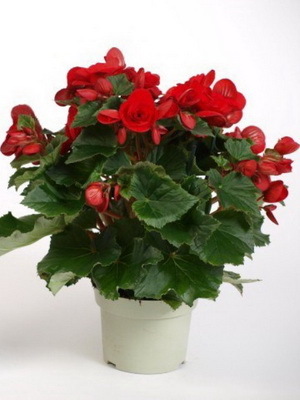
Elatior type begonias bred in England at the beginning of the 20th century from tuberous begonias. They bloom all year round with white, red, pink, yellow flowers. They are generally larger and brighter than the similar flowers of the Lorraine hybrids. In the Elatior group of begonias, the most popular are the Rieger begonias, which are named after the breeder.

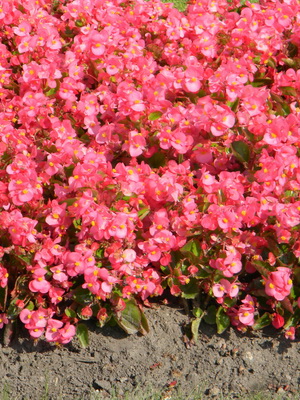
Hybrids of ever-flowering begonia (B. semperflorens) blooming all year round. They tolerate the sun better than the varieties listed above, and mainly grow in gardens and squares, in flower beds and lawns. They can also be planted in pots, especially begonias with decorative flowers.
Tuberous begonias.
Ever-flowering begonia -B. Semperflorens.


Flower lovers can be offered ever-flowering begonia. Caring for her is almost the same as for the royal begonia and its varieties. The only difference, perhaps, lies in the fact that the temperature of +18 ºС is comfortable for it. Until the beginning of flowering, this kind of begonia needs to be fed monthly with fertilizers, then it will be longer and more luxuriant. The AVA fertilizer is well suited for this. To make the plant look better, the faded flowers must be removed.
Flowering begonias are perennial and annual. Perennials are bush begonias, and annuals are tuberous. Of the perennials, I would like to note begonia, which reaches a height of 80 cm, blooms with red or white flowers, and its leaves with a silvery down. Of the annuals, begonia is especially good, blooming mainly in winter - with red, white or pink flowers. From hybrids, you can opt for begonias with large flowers, simple or double, the color scheme of which can be not only white and pink, but also red, and even yellow.
Wintering begonia -B. X hiemalis.


Plants with simple or double flowers in a wide range of shades, mainly red, pink, yellow, orange and white. They evolved from a cross between B. socotrana and tuberous begonias from South America.
Winter-flowering begonia - B. x cheimantha, or Loren's Begonia - B. Lorraine.
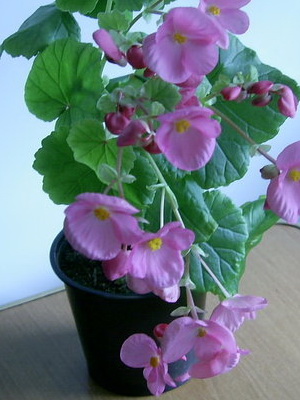

The name of this type of begonias is given for their ability to bloom in winter. The hybrid B. x cheimantha, obtained by crossing B. socotrana and B. dregei, blooms in winter and forms groups of small pink or white flowers. The pink-flowered Gloire de Lorraine is one of the best known varieties.
These photos show varieties of winter-flowering begonias:


Begonia Sutherland -B. Sutherlandii.


This type of houseplant begonia is an ampelous crop with small lanceolate leaves and an abundance of simple orange flowers in a loose inflorescence in the summer.
Many varieties of begonias are known, including:

Ampelny B. x t. pendula (Tuberous drooping begonia), with simple and double flowers, used for hanging baskets

B. x t. multiflora (Tuberous multiflorous begonia) with a mass of simple, semi-double and double flowers
The flowers are red, orange, pink and yellow. They all bloom during the summer months.
Reproduction of tiger begonias
Begonia: care
Begonias are propagated in several ways:
- a handle;
- seed;
- dividing the bush.

Tiger begonia will help propagate - cuttings
The most primitive and often used option to propagate tiger begonia is cuttings. It is worth considering this process in more detail:
- the average healthy leaf is cut off, the angle incision is 45 degrees;
- then it is placed in a glass of water so that it does not touch the bottom. In another case, the beginning of its decay is not excluded;
- a glass with a cut stem is placed in a semi-dark warm place, the temperature should be approximately 23 ° C warm;
- after 2 weeks from the moment the roots germinate, you can plant a new flower in the ground. The pot for this should not be very large - the plant can give all its strength to grow, and flowers will not appear on it for a very long time.
Diseases and pests
-
- Growing begonias in a cold room and high humidity cause the appearance of grayish mold on the buds. You won't be able to save the flowers - you will have to cut them off and throw them away. Treat the bush with any fungicide.
- Begonia begins to shed foliage due to lack of moisture and poor watering. Increase the amount of water when watering.
- With a lack of light, the leaves lose their attractiveness: they turn pale, shrink. Move the pot closer to the sun.
- Begonia refuses to bloom if it ceases to have enough nutrients. Feed your pet.
- The soft false shield sucks the juice from the stems and leaves, leaves a sugar coating on the elatior, in which sooty mushrooms gradually develop. The flower stops growing, stops blooming, fades. Pick the pests with your hands, and then wipe the plant with a piece of cloth dipped in a solution of pyrethrum or garlic.
- Greenhouse aphids can kill a plant in a couple of weeks. Both adults and larvae suck out all the nutrients from the plant, which causes rapid wilting. A solution of green or laundry soap can help: dissolve a bar weighing 300 grams in 10 liters of warm water, leave for two days, then strain and rinse the plant thoroughly. Repeat 3 times in a row every 4 days.
- Whitefly most often attacks greenhouse plants. And in this case, ordinary soap will come to the rescue: dilute 40 grams of laundry or tar soap in 10 liters of water and spray the plant until the pests are completely destroyed.
- The spider mite settles on the back of the leaves, lays eggs there, from which numerous gluttonous larvae emerge. They gnaw holes in leaves and stems, provoking the emergence of a "black leg". You can try to save the plant by washing it under the shower (do not forget to cover the soil with polyethylene) and treating it with Fitoverm or Omite. But if the defeat is large, destroy the plant by cutting off a couple of cuttings for breeding.
- The leaf nematode is perhaps the most dangerous enemy of begonia. It eats the buds and stems, which causes curvature, and then the death of the flower. If the plant is severely affected, it will not be possible to save it. At the very beginning of the disease, you can try to cure begonia with an organophosphate pesticide (for example, a heterophos solution).
Seed reproduction
Begonia seeds are very small. To get them, flowers are artificially pollinated, for which pollen from male flowers is transferred with a brush to the pistils of female flowers. To get blooming begonias in summer, the seeds must be sown in December-January in leafy soil, and you should not sprinkle it with earth.
The dishes with the planted seeds are tightly covered with glass in order to prevent the top layer of the substrate from drying out. The optimum temperature for seed germination is 22-25 ° C. The earth is periodically moistened. The glass needs to be opened from time to time so that there is no excess moisture and mold. Seedlings appear in 14-16 days.
They dive in the state of two cotyledon leaves into deciduous soil at a distance of 2 x 2 cm at a temperature of 20-22 ° C, after which they cover with glass for 2-3 days. When the leaves are closed, a second pick is made at a distance of 4 x 5 cm, and then a third - after 6 x 7 cm.
The soil mixture for the second and third picks is made up of 2 parts of deciduous, 1 part of sod land and peat, as well as 0.5 parts of sand (pH of the mixture is 6-6.5).
After the third pick, when the leaves close, the begonias are planted in 11-13-centimeter pots with a lump of earth, adding 1 part of deciduous soil, a little bone meal and pounded dry cow dung to the mixture.
After planting, watered abundantly, slightly shaded.
Often begonias are tall, unstable. To avoid this, during the formation of 5 leaves, the plants are sprayed with a growth regulator (retardant) - chlorocholine chloride (0.5% solution, 20-30 ml per plant), which inhibits growth. Under its influence, the plants have a compact, low bush with numerous flowers.
Young plants are planted in balcony boxes after the spring frosts have ended, at a distance of 20 cm from each other.
With seed reproduction, plants bloom 135-150 days after planting.

Biological description and photo
This perennial plant is a small but rather lush bush that grows up to 25-30 cm in height. As a rule, tiger begonia produces a lot of leaves that completely cover the stems. This creates a pleasant effect of a kind of green pillow that attracts the eye and lifts the mood of its owner.
For example, what a typical representative of tiger begonia looks like.
The foliage is small, up to 3-4 cm wide, although there are also larger species. The patterns are varied, always contain contrasting elements: alternating stripes, specks or a complex pattern in the form of symmetrical veins diverging from the center to the edges. The shape is round, ovoid, and sometimes complex: it resembles oak leaves.
Due to its peculiar color, the flower can be easily distinguished among dozens of other plant species. Even in the photo of the tiger begonia, you can see how it wins thanks to its peculiar pattern and contrasting transitions.
If you look closely at the leaves, many of them show small whitish hairs along the edges. Such fluff gives the plant its charm: it seems that this is a real masterpiece, created by nature itself. And also white fluff in combination with a tiger pattern suggests associations with tropical exoticism, which also cheers up well.
The plant blooms with white small flowers. In appearance, they resemble a butterfly and look pretty cute. Although, of course, the main source of inspiration is the original leaves. In addition, they will definitely be able to delight all year round, and not from time to time.


